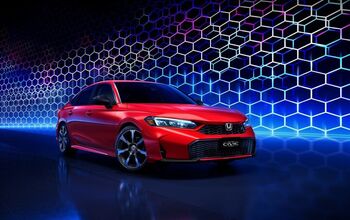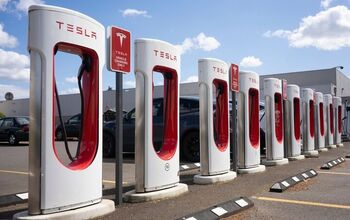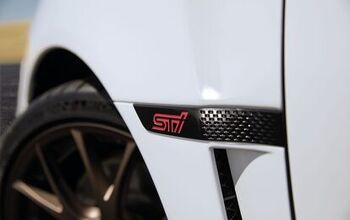Top 5 Wildest Concept Cars of the Geneva Motor Show

The annual Geneva Motor Show is most well-known for its debuts of various luxury and exotic vehicles, but the massive show floor in Switzerland is also filled with plenty of wild concept cars.
With creations from automakers you may have never even heard of in North America to the GT-R-powered Infiniti Q50 Eau Rouge, AutoGuide has assembled its list of the Top 5 wildest concept cars from the 2014 Geneva Motor Show.
SEE ALSO: 2014 Geneva Motor Show Coverage
The Giugiaro Clipper is Italdesign’s take on the Volkswagen MQB platform which underpins everything from the new Golf to the Audi TT. The company, which has made other wild concepts such as the Parcour concept (which debuted at the 2013 Geneva Motor Show), showed up with a three-row, six-passenger MPV concept featuring crazy doors inspired by both Lamborghini and the Tesla Model X.
The Giugiaro Clipper is an electric vehicle with a 335-mile range, powered by a pair of 110-kW electric motors. Each electric motor is mounted on each axle, making the Clipper an all-wheel-drive concept.
Inside, Giugiaro has packed the concept with Alcantara fabric and four iPad Minis integrated into the headrests for passengers seated in rows two and three.
While we’ve seen the Infiniti Q50 Eau Rouge before at the 2014 Detroit Auto Show, the Japanese automaker revealed what’s underneath the hood in Geneva. Boasting the same 3.8-liter twin-turbo V6 powerplant found in the Nissan GT-R, the Eau Rouge is actually under consideration for production, which is what makes it so wild.
The engine churns out 560 hp and 443 lb-ft of torque through an all-wheel-drive system. If it does see production, expect the Infiniti Q50 Eau Rouge to hit 60 mph from a standstill in under four seconds while sporting a top speed of over 180 mph. Is this the four-door GT-R everyone’s waiting for? It’s certainly an acceptable compromise.
This car has “extreme” written all over it. . . literally.
Billed as the fastest and most powerful Astra model ever, the Vauxhall Astra VXR Extreme previews the brand’s upcoming hot hatch powered by a 2.0-liter turbocharged engine with at least 296 hp – the same amount of power in the Astra Cup car that competed in last year’s Nurburgring 24 Hour race. Also borrowed from the race car variant is the automaker’s weight-savings techniques, dropping 220 pounds from the production Astra model with the aid of carbon fiber components on the body and wheels.
It’s not all about under-the-hood performance either, as Vauxhall has given the Astra VXR Extreme upgraded Brembo brakes and a race-inspired interior, removing the back seats and installing a roll bar along with a pair of Recaro seats and six-point harnesses.
This wild Hyundai concept is called the PassoCort. It is a design study built by Italy’s Instituto Europeo di Design (IED) in Turin. Last year, the school built the Alfa Romeo Gloria project, but this year it teamed up with the Korean automaker’s European design studio for this unique concept. As a result, it’s one sexy sports car featuring design elements that you wouldn’t expect from Hyundai. In a way, it clearly proves that IED and its students had creative reins over the PassoCorto’s design and Hyundai shouldn’t be shameful for taking notes.
Powering the car is a mid-mounted 1.6-liter twin-turbo four-cylinder engine with 270 hp.
With a mid-engine layout, the PassoCorto features sporty handling capabilities while the small engine offers a balance of fuel economy and performance.
Think of it as Hyundai’s Porsche Cayman.
Quite possibly one of the wildest concept cars we’ve ever seen, the Quant e-Sportlimousine is a fascinating concept car that is the product of energy company nanoFLOWCELL AG.
Teaming up with supercar maker Koenigsegg and Bosch, the Quant e-Sportlimousine is the first prototype build with the groundbreaking nanoFLOWCELL powertrain and energy-storage concept. According to the company, the nanaFLOWCELL battery technology gives the car a 373-mile electric driving range with 912 peak hp and 2139 lb-ft of torque.
Now you’re certainly curious as to how the nanaFLOWCELL technology works, so we’ll try our best to explain the new technology. The flow cells combine aspects of electrochemical accumulator cells with that of fuel cells. By using liquid electrolytes kept in two tanks and circulated through the cell, an electrical charge is able to pass through a membrane separating the two solutions to produce power for the powertrain.
SEE ALSO: Top 10 Cars of the 2014 Geneva Motor Show
The promising technology is confusing at best, and almost seems like something out of a sci-fi movie. But according to nanaFLOWCELL, the vehicle was “designed from the ground up to meet all homologation requirements.” Does that mean we’ll be seeing the technology in production vehicles in the near future? Only time will tell.

Jason Siu began his career in automotive journalism in 2003 with Modified Magazine, a property previously held by VerticalScope. As the West Coast Editor, he played a pivotal role while also extending his expertise to Modified Luxury & Exotics and Modified Mustangs. Beyond his editorial work, Jason authored two notable Cartech books. His tenure at AutoGuide.com saw him immersed in the daily news cycle, yet his passion for hands-on evaluation led him to focus on testing and product reviews, offering well-rounded recommendations to AutoGuide readers. Currently, as the Content Director for VerticalScope, Jason spearheads the content strategy for an array of online publications, a role that has him at the helm of ensuring quality and consistency across the board.
More by Jason Siu





































Comments
Join the conversation